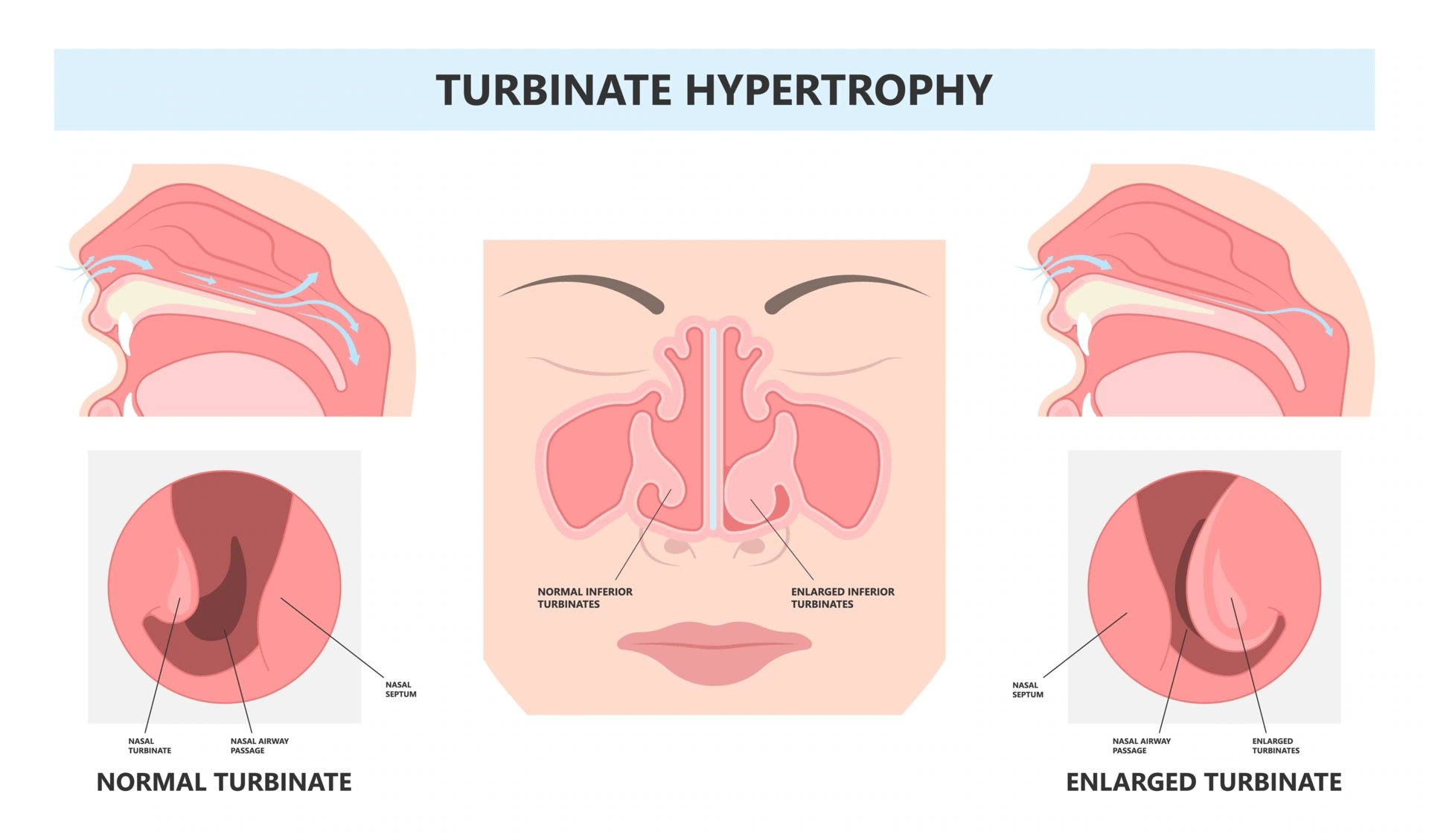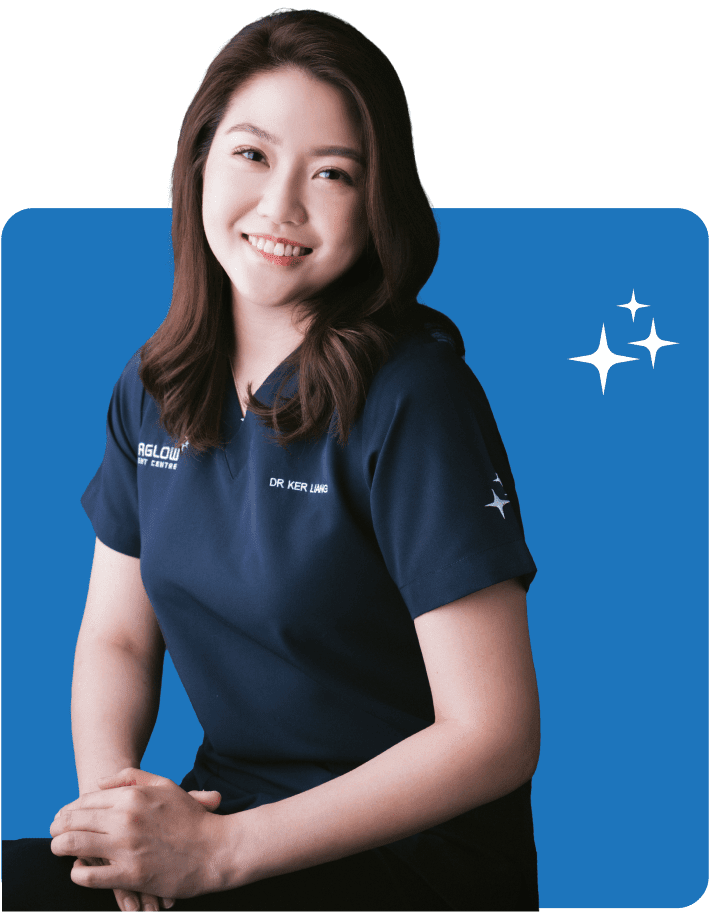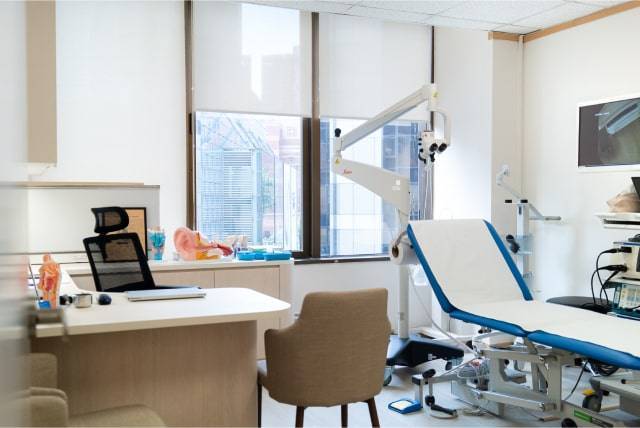Inferior Turbinate Hypertrophy

Inferior turbinate hypertrophy refers to the enlargement or swelling of the inferior turbinates in the nasal cavity, which leads to chronic nasal congestion and difficulty breathing. Understanding the anatomy of the nasal cavity, the function of the turbinates, the causes and symptoms of hypertrophy, and the available treatment options is crucial for effective management.
The nasal cavity is a complex structure integral to the respiratory system, playing a vital role in filtering, humidifying, and warming the air we breathe. Within this cavity lie the turbinates, small bony structures lined with mucosal tissue that regulate airflow and facilitate these processes. The inferior turbinates, the largest among them, can sometimes become enlarged, a condition known as inferior turbinate hypertrophy. This enlargement can lead to nasal obstruction, affecting breathing and overall well-being.
Understanding the Nasal Anatomy and Function of Turbinates
To fully grasp the impact of inferior turbinate hypertrophy, it’s essential to understand the nasal cavity’s anatomy and the turbinates’ function. The nasal cavity is divided into two passages by the nasal septum, with three pairs of turbinates (inferior, middle, and superior) projecting from its lateral walls. The inferior turbinates, in particular, play a crucial role in conditioning the air that enters our respiratory system.
The primary function of the turbinates is to increase the nasal cavity’s surface area, providing more space for the mucosal tissue to humidify, warm, or cool the air passing through, depending on the external temperature. They also help trap particles, acting as the first line of defence against environmental irritants and pathogens.
Causes of Inferior Turbinate Hypertrophy
Inferior turbinate hypertrophy can arise from various causes, often related to chronic inflammation or irritation of the nasal mucosa. Common contributing factors include:
Allergies: Allergic reactions can lead to persistent inflammation of the nasal mucosa, causing the turbinates to swell and enlarge.
Environmental Irritants: Exposure to pollutants, smoke, and extreme temperatures can irritate the nasal lining, contributing to turbinate hypertrophy.
Chronic Sinusitis: Long-standing sinus infections can cause ongoing nasal inflammation, leading to turbinate enlargement.
Hormonal Changes: Hormonal fluctuations, like those during pregnancy, can increase blood flow to the mucosal tissue, causing turbinate swelling.
Symptoms and Impact on Quality of Life

The enlargement of the inferior turbinates primarily manifests as nasal obstruction, making it difficult to breathe through the nose. This can lead to a variety of symptoms, including:
Difficulty Breathing: The most immediate and noticeable symptom, which can be particularly bothersome during physical activity or at night.
Snoring and Sleep Apnea: Nasal obstruction can contribute to snoring and may be a factor in sleep apnea, a condition characterised by repeated breathing interruptions during sleep.
Postnasal Drip: Increased mucus production can lead to a sensation of mucus flowing from the back of the nose into the throat.
Recurrent Sinus Infections: Impaired nasal airflow can lead to an increased risk of sinus infections.
These symptoms can significantly compromise an individual’s quality of life, disrupting sleep, limiting physical activity, and leading to chronic discomfort.
Diagnosis of Inferior Turbinate Hypertrophy
Diagnosing inferior turbinate hypertrophy involves a comprehensive evaluation by an otolaryngologist, starting with a detailed medical history and physical examination. Key diagnostic steps include:
Nasal Endoscopy: A small, flexible tube with a light and camera (endoscope) is inserted into the nasal passages, allowing the doctor to view the turbinates directly and assess their size and condition.
Imaging Studies: In some cases, CT scans may be used to provide detailed images of the nasal structures, helping to rule out other conditions that might cause similar symptoms, such as a deviated septum or nasal polyps.
Treatment Options
Treatment for inferior turbinate hypertrophy aims to reduce the size of the turbinates and alleviate nasal obstruction, with options ranging from conservative management to surgical intervention.
Medical Management: Initial treatment often involves medications to reduce inflammation and swelling, such as nasal corticosteroid sprays or antihistamines, especially if allergies are a contributing factor.
Surgical Options: If medical management is ineffective, surgical procedures to reduce the size of the turbinates may be considered. Techniques include turbinate reduction (turbinoplasty), where part of the turbinate is removed to widen the nasal passage, and radiofrequency ablation, which uses energy to shrink the turbinate tissue.
Lifestyle Changes and Home Remedies: Simple measures, such as using a humidifier to keep the nasal passages moist or saline nasal sprays to rinse and hydrate the mucosa, can provide symptom relief and support overall nasal health.
Preventive Measures and Long-Term Management
Managing underlying conditions that contribute to nasal inflammation, such as allergies or chronic sinusitis, is key to preventing inferior turbinate hypertrophy. Regular follow-up with an otolaryngologist is crucial for monitoring the condition and adjusting treatment as needed. Adopting healthy lifestyle habits, like avoiding smoking and minimising exposure to environmental irritants, can also help maintain nasal health and prevent further complications.
Conclusion
Inferior turbinate hypertrophy is a condition with a significant impact on nasal function and quality of life. Through a combination of medical treatment, possible surgical intervention, and lifestyle modifications, individuals can manage their symptoms and achieve significant relief. Understanding the causes, recognising the symptoms, and seeking timely medical care are crucial steps toward effective management and improved well-being. If you experience chronic nasal congestion or difficulty breathing, consult an otolaryngologist (ear, nose and throat specialist) at Aglow ENT Centre to explore your treatment options.
When should you see an ENT specialist in Singapore?
Please consult an ENT specialist if you are suffering from any ear, nose, or throat symptoms. It is also advisable to visit an ENT doctor if you experience persistent mouth breathing due to a chronic blocked nose or encounter snoring issues.
Dr Ker Liang sees adults and children for general ENT conditions and provides comprehensive management in a broad range of Ear, Nose, and Throat, as well as Head and Neck conditions. She has a special interest in treating throat and voice conditions, including persistent sore throat, voice issues, snoring, and Obstructive Sleep Apnoea (OSA).
Medical Teaching
Assistant Professor Ker Liang has a passion for teaching and is an Assistant Professor with NUS Yong Loo Lin School of Medicine (YLLSOM). As the NUS-NUH Otolaryngology Department Undergraduate Medical Director, Dr Ker Liang supervises the training of medical students from YLLSOM, NUS. She is actively involved
in the training of postgraduate junior doctors and residents in the Head and Neck Surgery department. She was conferred with an Undergraduate Teaching Award by the National University Health System in 2016 for her outstanding efforts as an Otolaryngology educator.
Medical Teaching
Assistant Professor Ker Liang has a passion for teaching and is an Assistant Professor with NUS Yong Loo Lin School of Medicine (YLLSOM). As the NUS-NUH Otolaryngology Department Undergraduate Medical Director, Dr Ker Liang supervises the training of medical students from YLLSOM, NUS. She is actively involved
in the training of postgraduate junior doctors and residents in the Head and Neck Surgery department. She was conferred with an Undergraduate Teaching Award by the National University Health System in 2016 for her outstanding efforts as an Otolaryngology educator.
Lorem ipsum dolor sit amet, consectetur adipiscing
Lorem ipsum dolor sit amet, consectetur adipiscing elit. Ut elit tellus, luctus nec ullamcorper mattis, pulvinar dapibus leo. Lorem ipsum dolor sit amet, consectetur adipiscing elit. Ut elit tellus, luctus nec ullamcorper mattis, pulvinar dapibus leo.
Lorem ipsum dolor sit amet, consectetur adipiscing
Lorem ipsum dolor sit amet, consectetur adipiscing elit. Ut elit tellus, luctus nec ullamcorper mattis, pulvinar dapibus leo. Lorem ipsum dolor sit amet, consectetur adipiscing elit. Ut elit tellus, luctus nec ullamcorper mattis, pulvinar dapibus leo.
Lorem ipsum dolor sit amet, consectetur adipiscing
Lorem ipsum dolor sit amet, consectetur adipiscing elit. Ut elit tellus, luctus nec ullamcorper mattis, pulvinar dapibus leo. Lorem ipsum dolor sit amet, consectetur adipiscing elit. Ut elit tellus, luctus nec ullamcorper mattis, pulvinar dapibus leo.
Lorem ipsum dolor sit amet, consectetur adipiscing
Lorem ipsum dolor sit amet, consectetur adipiscing elit. Ut elit tellus, luctus nec ullamcorper mattis, pulvinar dapibus leo. Lorem ipsum dolor sit amet, consectetur adipiscing elit. Ut elit tellus, luctus nec ullamcorper mattis, pulvinar dapibus leo.
Lorem ipsum dolor sit amet, consectetur adipiscing
Lorem ipsum dolor sit amet, consectetur adipiscing elit. Ut elit tellus, luctus nec ullamcorper mattis, pulvinar dapibus leo. Lorem ipsum dolor sit amet, consectetur adipiscing elit. Ut elit tellus, luctus nec ullamcorper mattis, pulvinar dapibus leo.



